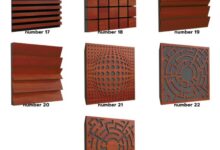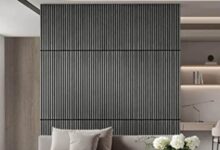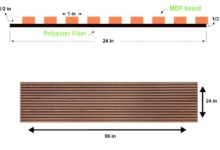How to Maximize Your Home Space with Windows
How to Maximize your Home Space with Windows: Unlocking the potential of your home’s windows can dramatically enhance your living space, creating a more inviting and spacious environment. From maximizing natural light to strategically choosing window treatments, this guide explores various techniques to transform your home’s interior. Learn how to effectively use windows to create a seamless connection with the outdoors and optimize the mood and ambiance of each room.
This comprehensive guide dives deep into the practical application of window-centric design strategies. We’ll explore techniques to optimize natural light, enhance visual space, and strategically use window treatments to achieve your desired aesthetic. You’ll discover how to maximize vertical space, cultivate a connection with the outdoors, and understand the impact of lighting on mood. By the end, you’ll possess the knowledge to effectively use windows to improve your home’s design and create a space you truly love.
Maximizing Natural Light
Natural light significantly impacts a space’s ambiance and functionality. Properly leveraging windows can transform a room from drab to dazzling, improving mood and even energy efficiency. By understanding window placement, size, and the role of window treatments, homeowners can optimize natural light for optimal comfort and style.Effective strategies for maximizing natural light involve careful consideration of room-specific needs and the use of light-reflective elements.
Different room types, from bedrooms to kitchens, require tailored approaches to harness the benefits of natural light. Window placement and size play a critical role in light penetration and distribution, while window treatments offer control over the amount and quality of light entering the space.
Window Placement and Size
Strategic window placement and appropriate size are crucial for maximizing natural light. East-facing windows capture morning sunlight, ideal for bedrooms and kitchens, while south-facing windows receive ample daylight throughout the day, making them suitable for living rooms and study areas. West-facing windows are excellent for capturing the evening sun, beneficial for dining areas and entertainment spaces. Larger windows naturally allow more light to enter, whereas smaller windows may require additional strategies to compensate.
The shape and orientation of the room also affect the way light is distributed.
Window Treatments
Window treatments play a significant role in regulating the amount and type of light entering a space. Different types of treatments offer varying levels of light control and aesthetic appeal. For instance, sheer curtains allow ample natural light to filter through, while heavier drapes offer greater privacy and light blockage. Blinds, particularly those with adjustable slats, provide precise control over light and privacy.
Shades, whether Roman or roller, offer a blend of light control and a clean aesthetic.
Comparison of Window Treatments
| Window Treatment | Light Control | Privacy | Aesthetic | Cost |
|---|---|---|---|---|
| Sheer Curtains | High | Low | Light and airy | Moderate |
| Heavy Drapes | Medium to High | High | Elegant and luxurious | High |
| Blinds (Venetian/Vertical) | Medium | Medium | Modern and functional | Moderate |
| Shades (Roman/Roller) | Medium to High | Medium | Clean and contemporary | Moderate to High |
This table provides a general comparison. Specific effects depend on the material and construction of each treatment.
Utilizing Mirrors
Mirrors can effectively reflect and amplify natural light within a room. Strategically placed mirrors can bounce light around the space, making it feel brighter and more open. This technique is particularly useful in rooms with limited natural light sources. Placing a mirror opposite a window, for example, can significantly increase the amount of light reflected into the room.
The size and shape of the mirror also influence its effectiveness. A large, well-placed mirror can create a significant visual impact, making a small room feel larger and brighter.
Enhancing Visual Space
Maximizing your home’s visual appeal is as crucial as maximizing its functionality. Large windows, strategically chosen window frames and colors, and thoughtfully selected window styles can transform a space, creating an illusion of openness and grandeur. This section dives into techniques to enhance visual space, weaving the interior and exterior together for a seamless and aesthetically pleasing environment.Large windows are powerful tools for creating a sense of spaciousness.
They offer panoramic views, allowing natural light to flood the room and making it feel significantly larger than it might otherwise appear. This effect is amplified when the windows extend across a significant portion of a wall, providing an unobstructed connection to the outdoors. By strategically placing large windows, you can visually expand the confines of a room, inviting the surrounding landscape into the interior.
Window Framing and Colors
Window frames, often overlooked, play a critical role in shaping the visual perception of a room. Choosing the right frame color can significantly impact the overall aesthetic and the feeling of spaciousness. Light-colored frames, such as white or light gray, tend to recede into the background, making the windows appear larger and allowing more natural light to penetrate.
Darker frames, while stylish in certain contexts, can sometimes visually narrow the window’s aperture, potentially diminishing the sense of spaciousness. The color of the frame should be carefully considered in relation to the surrounding walls and furnishings to ensure visual harmony and balance.
Window Styles and Space Perception
Different window styles evoke distinct moods and perceptions of space. Arched windows often lend a touch of elegance and drama, while bay windows create cozy alcoves and maximize natural light. Picture windows, with their expansive glass surfaces, are ideal for showcasing breathtaking views, visually extending the room’s boundaries. The selection of a particular style should be aligned with the desired ambiance and the overall design of the home.
Careful consideration of these factors can greatly enhance the visual impact of the windows.
Visual Continuity Between Interior and Exterior
Creating a seamless transition between the interior and exterior is vital for maximizing visual space. This can be achieved through consistent design elements that flow from the indoors to the outdoors. Using similar materials, colors, and textures in both areas can create a sense of continuity, minimizing the perceived separation between the two environments. For example, using similar furniture fabrics or flooring styles on the exterior patio can help tie the outdoor space to the interior, blurring the lines between the two.
Incorporating Outdoor Scenery
Windows are ideal for incorporating outdoor scenery into the interior design. Strategic placement and the selection of appropriate window treatments can effectively integrate the landscape into the living space. For example, strategically placed plants can enhance the visual connection between the interior and exterior. A strategically placed mirror can reflect the outdoors, expanding the visual perspective and creating a sense of spaciousness.
The interplay of light and shadow can also be utilized to enhance the perceived depth and beauty of the outdoor scenery.
Window Styles and Their Benefits for Visual Space
| Window Style | Benefits for Visual Space |
|---|---|
| Arched | Creates a sense of grandeur and elegance, can visually expand a room. |
| Bay | Maximizes natural light, creates cozy alcoves, visually expands the room. |
| Picture | Showcases breathtaking views, visually extends the room’s boundaries. |
| Large, Panoramic | Offers expansive views, floods the room with natural light, creates a strong sense of spaciousness. |
| Sliding | Allows for flexibility in the amount of light and views incorporated, creates an open, airy feel. |
Strategic Window Treatments

Maximizing natural light is crucial for creating a brighter, more inviting space. However, effective window treatments also play a vital role in managing privacy, controlling light levels, and significantly impacting the overall aesthetic of a room. Careful consideration of window coverings is key to achieving the desired ambiance and functionality.Window treatments are more than just decorative elements; they are essential tools for controlling the environment within a room.
Properly selected treatments can significantly enhance the comfort and usability of a space, balancing light and privacy needs while harmonizing with the room’s architecture.
The Role of Window Treatments in Light and Privacy Control
Window treatments are instrumental in regulating light penetration and maintaining privacy. They can diffuse harsh sunlight, soften glare, and create a more comfortable ambiance. Effective window coverings also provide privacy by obscuring views from the outside. This is particularly important in rooms where privacy is a priority, such as bedrooms or bathrooms. The level of privacy and light control offered depends greatly on the type of treatment and material used.
Types of Window Coverings
Various types of window coverings cater to different needs and preferences. These include curtains, blinds, shades, shutters, and roman shades, each with its own unique features and functionalities. Curtains, for instance, offer a wide range of fabric options, enabling significant control over light and privacy. Blinds, on the other hand, are known for their ability to adjust light levels with precision.
Shades provide a seamless and often modern aesthetic, offering effective light control. Shutters offer the most rigid form of light control and privacy, ideal for controlling the external environment. Roman shades combine elegance with functionality, providing both style and light control.
Comparing Window Treatment Materials
The material of a window treatment directly impacts its performance in terms of light control, privacy, and aesthetic appeal. Linen, for example, is a natural fiber known for its breathability and texture, but it might not offer the same level of light blockage as a heavier material. Cotton, another natural fiber, offers a softer aesthetic and is often more affordable than other options.
Silk, with its luxurious feel, provides a touch of elegance but may be more expensive and less durable than other choices. Polyester, a synthetic material, often provides better light blockage and is more resistant to wear and tear.
Impact on Room Aesthetics
Window treatments significantly influence the overall aesthetic of a room. The choice of material, color, and pattern can significantly impact the mood and ambiance. Light-colored, sheer fabrics can create a sense of spaciousness and openness, while darker, heavier fabrics can create a more intimate and secluded atmosphere. The style of the window treatment should complement the architectural style of the home.
You also can investigate more thoroughly about Ultimate luxury hotel experiences in the Middle East to enhance your awareness in the field of Ultimate luxury hotel experiences in the Middle East.
Table of Window Treatment Materials and Benefits
| Material | Benefits | Drawbacks |
|---|---|---|
| Linen | Breathable, natural, textured, adds warmth | Less light blocking, potentially wrinkles easily |
| Cotton | Soft, affordable, natural, versatile | Less durable than linen, may not offer the same level of light blocking |
| Silk | Luxurious, elegant, soft | Expensive, less durable, may require more care |
| Polyester | Durable, good light blocking, wrinkle resistant, often affordable | Can feel less natural, may not have the same aesthetic appeal as natural fibers |
Choosing Window Treatments that Complement Architectural Style
The selection of window treatments should harmonize with the architectural style of the home. A traditional home might benefit from elegant curtains or shutters, while a modern home might be better suited to sleek blinds or shades. Consider the overall color palette and design elements when choosing window treatments to create a cohesive and visually appealing space. Understanding the interplay between window treatments and the existing architecture ensures a unified and aesthetically pleasing environment.
Maximizing Vertical Space: How To Maximize Your Home Space With Windows
Elevating a room’s perceived height is crucial for maximizing its overall space. Clever use of windows, in conjunction with strategic design choices, can dramatically transform a room’s atmosphere. This section delves into techniques for using windows to visually extend the vertical dimension of a space, from window placement to incorporating vertical elements.Utilizing windows to create an illusion of height is a powerful design strategy.
By thoughtfully considering the relationship between window height and the overall room design, you can significantly impact the way the space is perceived. Strategic window placement, combined with thoughtful design elements, can make a small room feel grander and a large room feel more intimate and inviting.
Window Placement and Design for Verticality, How to Maximize your Home Space with Windows
Effective window placement is fundamental to creating a sense of verticality. Higher windows, particularly those that reach the ceiling, visually elongate the room, making it feel taller. Positioning windows near the ceiling line, while maintaining adequate headroom, can dramatically affect the perceived height of a room. The placement and design of windows should harmonize with the room’s overall architectural style.
For example, in a contemporary design, a floor-to-ceiling window might be a statement piece, while in a more traditional setting, a series of smaller, strategically placed windows could achieve a similar vertical effect.
Incorporating Vertical Elements Around Windows
Integrating vertical elements around windows can further enhance the feeling of height. Tall, slender plants, positioned near or alongside windows, visually extend the vertical plane. Tall, vertical artwork, such as a series of framed prints or a long, narrow piece of art, creates a similar visual effect. Consider arranging mirrors on walls opposite windows; the reflection can make the room appear taller and brighter.
Vertical lighting fixtures, like tall pendant lights or slim floor lamps, can also contribute to the feeling of vertical space.
Window Treatments for Height Enhancement
Window treatments play a significant role in defining the vertical dimension of a room. Floor-to-ceiling curtains or blinds, particularly in light and airy materials, can visually stretch the room’s height. Avoid heavy, bulky treatments, as these can make the room feel cramped. Sheer, light-filtering curtains or blinds, in a light color, will let in natural light and contribute to the sense of vertical space.
Vertical blinds or shades can also visually enhance the vertical dimension. Experiment with different window treatment styles and colors to find what works best for the room’s aesthetics.
Relationship Between Window Height and Room Perception
The height of the window directly influences the overall feeling of a room’s height. Higher windows contribute to a more spacious and airy atmosphere. Lower windows, while functional, might not create the same sense of verticality. The relationship between window height and the overall room design is crucial. If a room is already high-ceilinged, a tall window can create an impressive focal point.
If the ceilings are lower, the careful selection of a smaller window and appropriate window treatments can create an aesthetically pleasing and visually balanced space.
Tips for Making a Room Appear Taller Using Windows
- Maximize natural light: Light-colored window treatments and large windows allow ample natural light to flood the space, creating a sense of spaciousness and height.
- Vertical lines: Incorporate vertical lines in the room’s design, such as tall furniture, vertical artwork, and tall plants.
- Floor-to-ceiling treatments: Use floor-to-ceiling curtains or blinds to visually extend the room’s height.
- Strategic window placement: Place windows near the ceiling line to maximize the vertical effect.
- Avoid heavy window treatments: Heavy drapes or blinds can make a room feel smaller; instead, opt for sheer, light-colored treatments.
- Mirror placement: Mirrors opposite windows can reflect light and make the room appear larger and taller.
- Minimalist design: Keep the overall design minimalist to avoid cluttering the space and allow the vertical elements to stand out.
Creating a Connection with the Outdoors
Breathing life into your home often involves more than just aesthetics; it’s about forging a meaningful connection with the surrounding environment. This connection is powerfully facilitated by windows, which act as portals to the outdoors, bringing the natural world indoors and enriching the overall living experience. Integrating the beauty of nature into your interior design not only enhances the visual appeal but also contributes to a healthier and more balanced atmosphere.The essence of creating an indoor-outdoor flow hinges on strategically utilizing windows.
This involves thoughtfully considering the natural light filtering in, the views they frame, and the integration of natural elements. Effective window treatments and carefully chosen furniture arrangements further accentuate this harmonious connection. This approach transforms your home into an extension of the surrounding landscape, fostering a sense of serenity and tranquility.
Maximizing Outdoor Views
A key aspect of connecting with the outdoors is leveraging the views available through your windows. These views can profoundly impact the ambiance of a room, transforming it from ordinary to extraordinary. Panoramic vistas, verdant landscapes, or tranquil water features can evoke feelings of peace, wonder, and inspiration.
Incorporating Natural Elements
Bringing the outdoors in extends beyond simply appreciating views. Strategically incorporating natural elements like plants, wood, and stone can create a seamless transition between indoor and outdoor spaces. Plants, in particular, can introduce life and vibrancy, purifying the air and enhancing the aesthetic appeal of the room. Consider incorporating potted plants of varying sizes and textures to create a layered effect that mirrors the diversity of the natural world.
Designing for Natural Ventilation
Maximizing natural ventilation through windows is a crucial aspect of creating a connection with the outdoors. Proper placement of windows and strategically positioned openings can improve airflow and reduce reliance on mechanical systems. Consider installing operable windows, skylights, or other ventilation solutions to optimize natural air circulation, reducing energy consumption and promoting a healthier indoor environment.
Design Ideas for Large Windows
Leveraging large windows to showcase outdoor views is a powerful design strategy. The sheer size of the window can dramatically enhance the sense of space and allow for more of the surrounding landscape to be seen. Here are some design ideas to showcase outdoor views through large windows:
- Full-length curtains or sheer drapes: These can be drawn back to fully embrace the view or pulled to offer privacy when needed. Consider the fabric’s texture and color to complement the existing décor and outdoor scenery. The interplay of light and shadow created by these treatments can add depth and dimension to the space.
- Strategically placed furniture: Position furniture in a way that frames the view and allows for optimal enjoyment of the surrounding scenery. This might involve placing seating areas near large windows or arranging furniture to create a focal point towards the view.
- Mirrors: Strategically placed mirrors can reflect the outdoor view, creating an illusion of greater depth and openness. This technique is particularly effective in smaller rooms, maximizing the perception of space and incorporating the outdoors.
- Outdoor living spaces: Consider extending the indoor space outdoors by creating a seamless transition between the interior and exterior. This could involve a covered patio or deck directly connected to the room, allowing for indoor-outdoor living.
Lighting and Mood
Natural light dramatically impacts the mood and ambiance of a space. Its warm glow can create a cozy atmosphere, while abundant light fosters a sense of openness and spaciousness. Understanding how to harness natural light is crucial to maximizing the potential of any room.Proper utilization of natural light can transform a space, shifting from feeling cramped and dark to airy and inviting.
This optimization requires a thoughtful approach to window placement, size, and treatments, as well as a consideration for how artificial light sources can complement and enhance the natural illumination.
Natural Light’s Influence on Mood
Natural light is more than just illumination; it significantly influences the psychological and emotional responses within a space. Studies have shown that ample natural light can reduce stress, improve concentration, and boost overall well-being. A brightly lit room can feel more energetic and uplifting, whereas a dimly lit space may induce feelings of gloominess or confinement.
Optimizing Natural Light with Window Placement and Size
Window placement and size are critical factors in determining the amount of natural light a room receives. South-facing windows, for instance, generally receive the most direct sunlight throughout the day, creating a warm and inviting ambiance. Larger windows allow more light to enter, while smaller windows, strategically placed, can still provide significant illumination. Positioning windows to maximize sunlight throughout the day is a key element in space design.
Complementing Natural Light with Artificial Lighting
Artificial lighting plays a vital role in supplementing natural light, particularly during the evening hours or in rooms with limited natural light. The key is to choose artificial lighting that harmonizes with the natural light, rather than competing with it. Soft, warm-toned bulbs complement natural light, while harsh, cool lighting can clash with the ambiance. Consider using LED lighting, known for its energy efficiency and versatility in creating the desired mood.
Window Treatments for Light Adjustment
Window treatments are essential tools for controlling the amount of natural light entering a room. Blinds, curtains, and shades can be used to filter or block sunlight, offering versatility in adjusting the brightness and warmth of the space. Sheer curtains allow light to filter through while maintaining privacy, while heavier drapes can block light completely, creating a more intimate and private atmosphere.
The choice of window treatment directly affects the overall ambiance of the room.
Room Design Examples for Effective Natural Light Use
Rooms with large windows, strategically placed to maximize sunlight, create a sense of openness and spaciousness. Using light-colored walls and furnishings reflects light, making the space feel brighter and more expansive. A well-designed room can take advantage of natural light to create a positive and engaging environment. Integrating a variety of window treatments, such as sheer curtains for daytime and heavier drapes for nighttime, provides flexibility in managing the light levels throughout the day.
For example, a living room with large windows facing a garden can create a seamless connection between indoor and outdoor spaces, enhancing the room’s ambiance and mood.
Window Design Considerations
Transforming a space often hinges on the careful consideration of window design. Beyond mere functionality, windows profoundly impact a home’s aesthetic, influencing its overall style and creating a cohesive visual narrative. Understanding the relationship between window design and architectural style, and the selection of appropriate materials, is crucial for achieving a harmonious and visually appealing interior.Window design choices can significantly influence the overall style of a home, from modern minimalism to rustic charm.
Selecting the right window type, size, and frame material can enhance the home’s aesthetic appeal and create a cohesive design narrative. The careful consideration of window design, therefore, is not just about functionality but about expressing a specific aesthetic and crafting a unified style throughout the house.
Window Design and Architectural Style
The relationship between window design and architectural style is undeniable. Classical architecture, for instance, often features large, symmetrical windows with detailed frames. Modern styles, conversely, frequently utilize expansive, unobstructed glazing, showcasing the surrounding landscape. Choosing windows that complement the existing architectural style creates a more unified and visually appealing home. This approach ensures the windows harmoniously integrate with the overall design, preventing a jarring disconnect.
For example, a Victorian home benefits from ornate, multi-paned windows, while a contemporary structure would be better suited with clean-lined, single-pane windows.
Window Materials and Their Properties
The choice of window material significantly impacts both the aesthetic and functional qualities of a home. Various materials offer distinct advantages and disadvantages in terms of energy efficiency, durability, and appearance.
- Wood: A classic choice for its natural beauty and inherent warmth. Wood windows can enhance the character of a home. However, they require regular maintenance to prevent rot and decay, and they are generally more susceptible to moisture damage compared to other materials.
- Vinyl: A popular option due to its affordability, low maintenance, and excellent energy efficiency. Vinyl windows are resistant to warping and rot, making them a long-term investment. Their low maintenance is a significant advantage. However, their aesthetic appeal may not be as high as wood, and they can sometimes lack the rich character of other materials.
- Aluminum: Known for their durability and strength, aluminum windows are resistant to harsh weather conditions. They offer excellent insulation and energy efficiency, and their modern appearance can create a contemporary look. However, aluminum windows can be prone to fading or discoloration over time, especially in high-sun environments. Their durability can be a disadvantage in certain climates.
- Composite: A modern material combining the strengths of different materials, like wood and vinyl, composite windows offer high energy efficiency, low maintenance, and excellent durability. They provide a blend of aesthetic appeal and practical benefits. Composite windows are often a compromise between high-end aesthetic and practicality, offering a balance between the pros and cons of various materials.
Comparison of Window Materials
| Material | Pros | Cons |
|---|---|---|
| Wood | Natural beauty, warmth, character | Requires maintenance, susceptible to moisture |
| Vinyl | Affordability, low maintenance, energy efficiency | May lack aesthetic appeal, less character |
| Aluminum | Durability, strength, energy efficiency, modern appearance | Prone to fading, discoloration |
| Composite | High energy efficiency, low maintenance, durability, aesthetic appeal | May not match specific architectural styles |
Closing Summary
In conclusion, maximizing your home space with windows goes beyond just aesthetics. It’s about crafting a harmonious blend of light, visual appeal, and a strong connection to the outdoors. By thoughtfully considering window placement, treatments, and design, you can transform your home into a more functional, beautiful, and inviting space. Implementing the strategies Artikeld in this guide will not only enhance your home’s interior but also elevate your overall living experience.
Remember, well-designed windows are key to creating a home that feels both spacious and uniquely yours.









